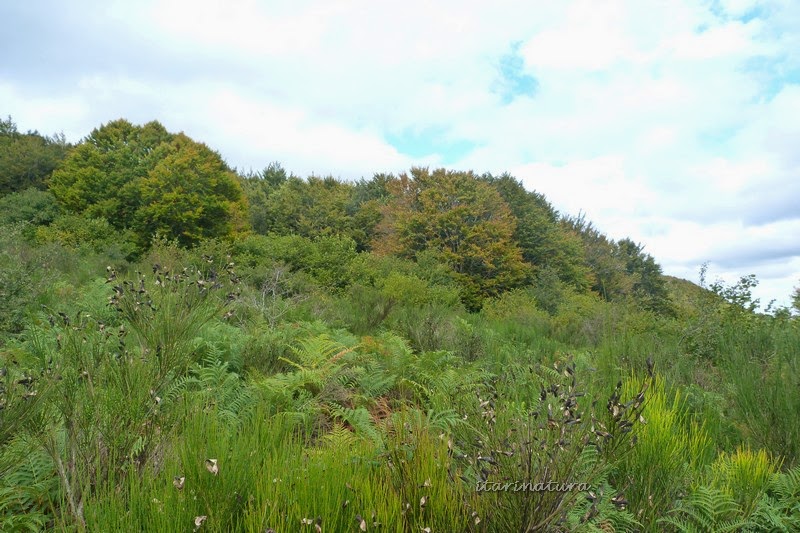 |
| 12 september 2014 Aribe ( Aezkoa valley) |
And by the way I will comment that this painted wall corresponds to Trigolimpio, an association of local farmers dedicated to market their organic meat of pony, beef and lamb from our Pyrenean valleys who lives in fabulous condition which we can see if we go to the higlands of Irati, and the sale reverts entirely in them, without intermediaries, enabling the survival of the livestock on these lands. I encourage you to taste it.
http://carneecologicanavarra.com/index.php?id_category=7&controller=category&id_lang=1
As you can see in the following photo, the colors of Irati take to come yet, and as usual, about 1 month, which is not to say that the forest is not pretty.
The warm temperatures, lack of consistent rain, the subsequent lack of wind, and it's still early, makes the leaf fall does not arrive.
 |
| Irati near from Orbaizeta old munition factory , 26 september 2014 |
I add you some photos to look the colour of the forest. They already have more color, but there are still lots of green. My forecast is still for the last week of October, first of November.
 |
| Aezkoa valley, from Orbaizeta, 1km to Irati |
 |
| View of the Ori mountain (Salazar valley,) from Orbaizeta (Irati south west) |
 |
| Beeches and Scotch brooms (Cytisus scoparia) |
 |
| Hygroscopic earthstar( Astraeus higrométricus) |
The rain and cold, and because we are in the middle of the autum, they are favoring the final color changement. On the summits from 1200 meters,we can begin seeing the snow, and the color of the forest has increased very much. In the valleys we have still up to 40% green.
If you come this weekend, you will find it quite nice, and probably will not last much longer.
 |
| Olaldea /Garralda Oak forest, few kilometres to the south of Irati |
 |
| Arpea Cave ( Garazi/ Cize Valley) |
Mushrooms have been a shy presence due to the high temperatures and lack of moisture, butspecies like the Amanitas seems get very well.
 |
| Fly amanita (Amanita Muscaria) |
You can see the size of this item, it´s big like a hat:
 |
| Parasol mushroom (Macrolepiota procera) |
 |
| As big as a hut.. |
With the rut this year we had something similar; although normal in other years was to start around 15 September, this year has been delayed a lot, and it was not until earlier this week, on Monday 20, Tuesday 21, which has not begun to hear and low intensity and duration.
But what most people are waiting for is the begining of mushroom season.
The boletus edulis, or Porcini, onddo beltza called here, have not yet come out in significant number, but many months we started harvesting other types of mushrooms, such as Sweet tooth or Tripaki (Hydnum repadnum), the horn of plenty (Cratarellus cornucopioides), or the Zizahori or Chanterelle,(cantharellus cibarius), among others.
Obviously, there are also toxics, mortals and indigestibles, and that makes (and they do well) that many people they dont catch species unknowns.
What is best in my opinion, is to go slowly, expanding knowledge and continue to consume only those which are safe, but now some of them more.
Therefore, every Saturday afternoon in October, we offer guided tours to the mountains, where we will see many things as usual, but also we will pick,mushrooms, goods and not edible specimens, later to classify them according to some simple keys of GARRAPO,company, and then have dinner every Saturday at a different restaurant in the valley, prepared differently, and all for a fixed price of € 40 + VAT.
They will be small groups of no more than 10 people, because is a lot of work to clean and cook the mushrooms almost the same time that we give they.
Places are still available for the 4 Saturdays, so I encourage you!
CALENDAR OF TOURS AND DINNERS IN AEZKOA (NAVARRE)
v 4 october PARDIX Restaurant (Orbaizeta) 948 76 60 01
v 11 october ARIBE Hotel Restaurant (Aribe) 948 76 44 66
v 18 october HERRIKO OSTATUA Bar (Garralda) 618 10 73 79
v 25 october SARIGARRI inn (Abaurrepea) 948 76 90 61
The company GARRAPO are friends and managers of the mycological Ultzama Park whose magnificent web I recommend you, ,http://www.parquemicologico.com/
With them I did last year a training course to complete the knowledge I already had beforehand, because when I was I went going with my family in many times to take mushrooms.
Finally, I will commentyou something about the fascinating world of fungi;
The photo that you have below is the Armillaria ostoyae, somewhat old. It is a fungus that can be a pest because rot the healthy wood ,It is edible, although here there are no custom of eating.
The amazing thing about this fungus, and probably many others, is that in Oregon (USA), there is a clonal colony of this fungus, and at the moment, is the largest known organism with more than 890 hectares and 2400 years old.
Do not imagin a typical mushroom out ground.Is the mycelium, like the roots, going underground among the roots of trees.
 |
| Armillaria ostoyae in Irati |
 |
| Lactarius piperatus |
 |
| The strange mushroom ( Phragmobasidiomicetes?) |
 |
| Charcoal burner or Gibelurdina (Russula Cyanoxantha) |

No comments:
Post a Comment